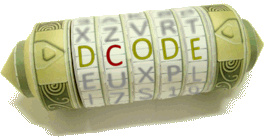Tool to compute coincidence index (IoC) in cryptanalysis, in order to study the probability of finding repeating letters in an encrypted text.
Index of Coincidence - dCode
Tag(s) : Cryptanalysis
dCode is free and its tools are a valuable help in games, maths, geocaching, puzzles and problems to solve every day!
A suggestion ? a feedback ? a bug ? an idea ? Write to dCode!
Index of Coincidence
Cryptanalysis using Index of Coincidence
Answers to Questions (FAQ)
What is the index of coincidence? (Definition)
The index of coincidence (IC or IoC) is an indicator used in cryptanalysis which makes it possible to evaluate the global distribution of letters in an encrypted message for a given alphabet.
A text written in the English language has an index of coincidence of 0.0667. The use of certain ciphers on a message in English will tend to modify this value which can allow them to be recognized. See dCode's cipher identifier.
How to calculate a coincidence index?
Index of coincidence uses the formula:
$$ IC = \sum_{i=A}^{i=Z} \frac{n_{i}(n_{i}-1)}{N(N-1)} $$
with $ n_i $ the number of occurrences of the letter $ i $ in the text and $ N $ the total number of letters.
This index was probably invented by William F. Friedman.
How to use an Index of Coincidence?
For a given ciphered message, the value for the IoC allows to filter the list of ciphering methods to use. It is one of the first cryptanalysis techniques.
If the Index of coincidence is high (close to $ 0.070 $), i.e. similar to plain text, then the message has probably been encrypted using a transposition cipher (letters were shuffled) or a monoalphabetic substitution (a letter can be replaced by only one other).
If the Index of coincidence is low (close to $ 0.0385 $), i.e. similar to a random text, then the message has probably been encrypted using a polyalphabetic cipher (a letter can be replaced by multiple other ones).
The more the coincidence count is low, the more alphabets have been used.
Example: Vigenere cipher with a key of length 4 to 8 letters have an IC of about $ 0.045 \pm 0.005 $
What are values of IC among languages?
For an unencrypted text, coincidence indexes are
| English | 0.0667 | French | 0.0778 |
|---|---|---|---|
| German | 0.0762 | Spanish | 0.0770 |
| Italian | 0.0738 | Russian | 0.0529 |
What is a random text?
A text where each letter has the same probability of appearance than another, IC is then of $ 1/N $ (where $ N $ is the number of letters in the alphabet)
Example: $ IC = 0.0385 $ for $ N=26 $
How to calculate a key size from the IC?
In the case where multiple alphabets are used and the key size determines the number of alphabets (as for the Vigenere cipher), by denoting $ n $ the total number of letters in the message and $ m $ the key size, a new coincidence index can be calculated by the formula:
$$ IC = \frac{n-m}{m(n-1)}} \cdot IC_{\text{lang}}} + \frac{n(m-1)}{(n-1)m} \cdot 0.0385 $$
How to code an IC function? (Algorithm)
Examples of codes in programming languages // Python
def ic(self):
num = 0.0
den = 0.0
for val in self.count.values():
i = val
num += i * (i - 1)
den += i
if (den == 0.0):
return 0.0
else:
return num / ( den * (den - 1))
Source code
dCode retains ownership of the "Index of Coincidence" source code. Any algorithm for the "Index of Coincidence" algorithm, applet or snippet or script (converter, solver, encryption / decryption, encoding / decoding, ciphering / deciphering, breaker, translator), or any "Index of Coincidence" functions (calculate, convert, solve, decrypt / encrypt, decipher / cipher, decode / encode, translate) written in any informatic language (Python, Java, PHP, C#, Javascript, Matlab, etc.) or any database download or API access for "Index of Coincidence" or any other element are not public (except explicit open source licence). Same with the download for offline use on PC, mobile, tablet, iPhone or Android app.
Reminder: dCode is an educational and teaching resource, accessible online for free and for everyone.
Cite dCode
The content of the page "Index of Coincidence" and its results may be freely copied and reused, including for commercial purposes, provided that dCode.fr is cited as the source (Creative Commons CC-BY free distribution license).
Exporting the results is free and can be done simply by clicking on the export icons ⤓ (.csv or .txt format) or ⧉ (copy and paste).
To cite dCode.fr on another website, use the link:
In a scientific article or book, the recommended bibliographic citation is: Index of Coincidence on dCode.fr [online website], retrieved on 2026-01-02,
